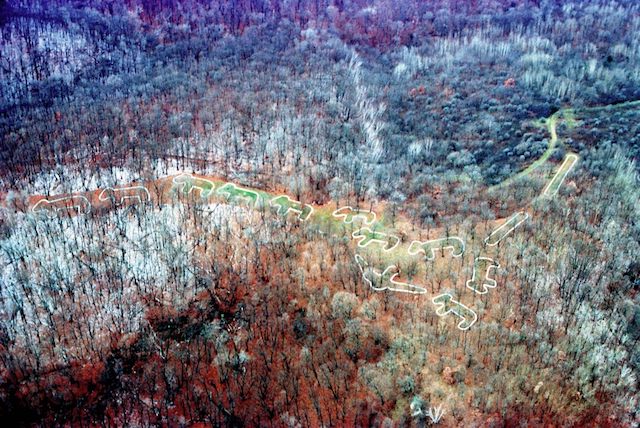
A 1970s aerial photograph of the Marching Bear group of mounds. An archeologist and students from Luther College in Decorah had outlined the mounds with agricultural lime so they could be visible and photographed from a plane overhead. The portion of trail shown in the photo is the old military road that existed between Fort Crawford in Wisconsin and Fort Atkinson in Iowa. Today, that section continues to be used as the hiking trail to the Marching Bear mounds. Photo courtesy of Effigy Mounds National Monument, National Parks Service
March/April 2023 (Volume 15, Issue 2)
By Carson Ode
During the late 19th century, United States leaders had the foresight to see the need to preserve parcels of land in its natural state. They were especially concerned that the rapid development of the West would encroach on pristine sites of natural beauty.
Geysers, hot springs and holes of bubbling mud in a setting of beautiful forests and mountains, teaming with indigenous wild life, are the features of the first national park. Congress approved the legislation in 1872 and President Ulysses S. Grant signed the bill designating 2.2 million acres of the northwest corner of Wyoming to be preserved. It was given the name Yellowstone National Park. Today there are 63 national parks. Twenty states have no national parks; Iowa is one of them.
The cousins of national parks are national monuments. The Antiquities Act of 1906 gave presidents the power to proclaim national monuments by executive action. Later that year, President Theodore Roosevelt declared Devils Tower in Wyoming as the first national monument. National monuments vary from national parks in that they include a wide variety of natural and historic resources. And, it doesn’t take an act of congress to establish one. A National Park Service was created in 1916, signed by President Woodrow Wilson, to manage the national parks. The national monuments are managed by several federal agencies including the National Park Service.
The Effigy Mounds National Monument was established on Oct. 25, 1949, on 3,776 square miles in northeast Iowa. The word “effigy” conjures up a vision of the symbolic burning or hanging of crude figures in protest of controversial people. The Effigy Mounds, however, are believed to be an effort of preserving the mortality of the Woodland Indians who roamed the Upper Midwest area of Minnesota, Wisconsin, Iowa and Northern Illinois.
Archaeologists define the Woodland period between about 2,500 and 900 years ago. The Effigy Mound culture of the Woodland Indians extends from Dubuque, north into Southeast Minnesota, across Wisconsin to Lake Michigan and along the Wisconsin–Illinois border.
The Effigy Mounds of the Woodland Indians are dirt piles in the stylized shape of animals such as birds, turtles, bears, panthers and humanoid forms. Bears and birds are the dominant shape in Iowa. The Indians also built linear or long rectangular mounds that remain a mystery. It is believed the mounds were constructed for religious purposes, the animals being sacred in the Woodland Indian culture. One or more people were buried in a single mound—often done singly with one on top of the other in successive years. There is a lack of artifacts accompanying the dead, unlike ancient cultures where the self-important dead tried to take it with them. It is speculated the effigy mound builders were egalitarian people.
Clues to the mounds can be found in American Indian legends and mythology. Science provides limited resources. Stories by American Indians whose ancestors built the mounds describe the effigy mounds as ceremonial and sacred sites. Archeologists believe the mounds marked territories of choice gathering and hunting grounds.
Some believed the mounds were primarily ceremonial. Others believed that disturbance of a mound would bring suffering to the descendants of the deceased. Not every mound contained burial material. Unfortunately, little is conclusive.
It is documented that there were more than 10,000 mounds in northeast Iowa. One thousand have survived. Prior to European colonization, there might have been more than 15,000 mounds in Wisconsin. Most were destroyed by encroaching colonists. It is estimated about 4,000 remain today. Many of the Wisconsin burial mounds can be found in state parks, forests and other properties. Fortunately, excellent examples of the mound builders’ efforts are preserved in northeast Iowa at the Effigy Mounds National Monument.
TO READ THE ENTIRE STORY AND OTHER FASCINATING STORIES ABOUT IOWA HISTORY, subscribe to Iowa History Journal.
